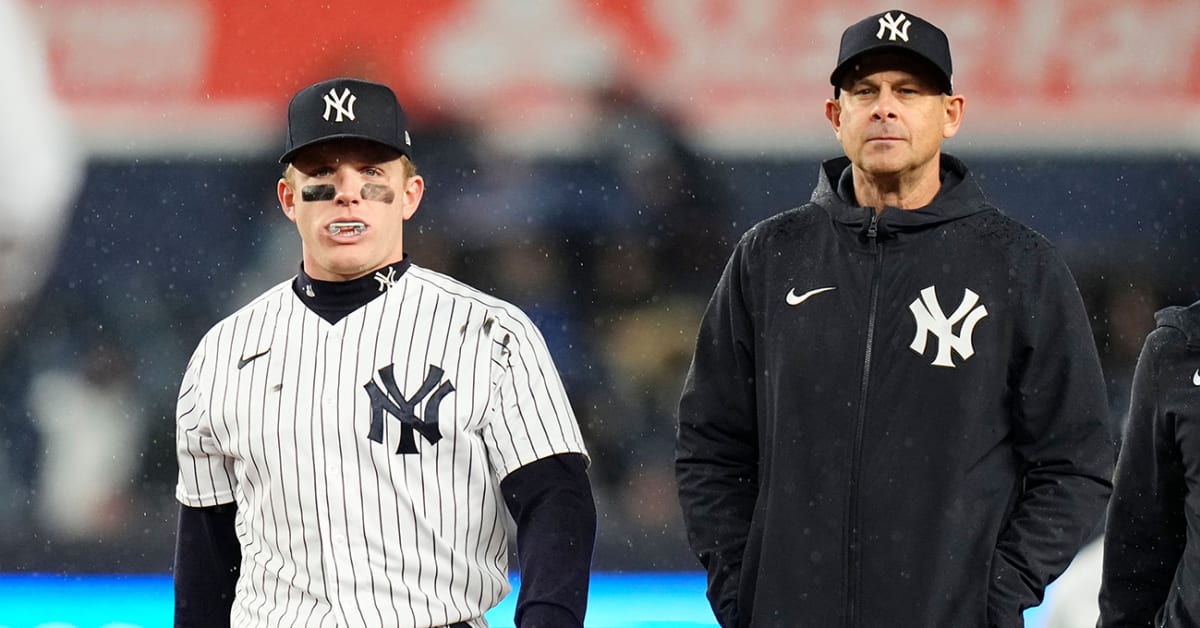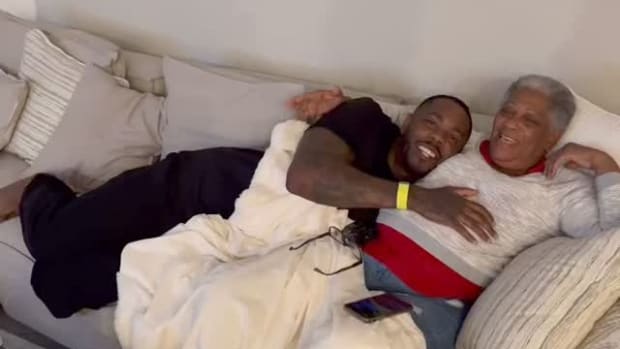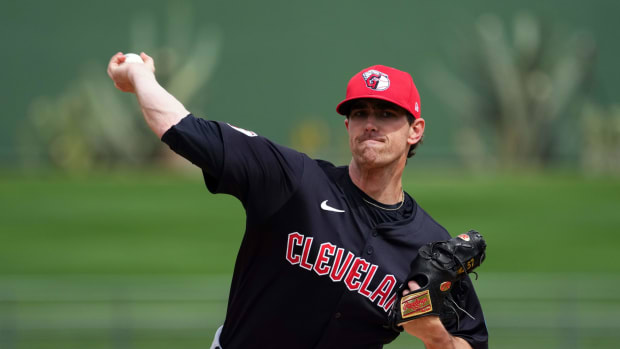The Panic Button Not So Far Away For These Five MLB Teams
The 2021 Braves stand as the patron saints of slow starts. Atlanta started 19–23 and never surfaced above .500 until August, but somehow won 88 games and the World Series.
It did take the team adopting massive defensive shifts midstream, remaking their entire outfield at the trade deadline and a 21–36 collapse by the Mets to get there, but, hey, the 2021 Braves give hope to all underachieving clubs—even if it means ignoring the 10 slow-starting teams for every ’21 Braves team that never did get untracked.
Yankees general manager Brian Cashman pleaded this week for a little patience. In New York, as Billy Beane once put it, that’s measured in the nanosecond between when the traffic light turns green and the guy behind you leans on his horn.
But should Yankees fans be worried? What about fans of the Mets, Mariners, Cardinals and White Sox? Slow starts mean thinning the margin of error. Entry to the postseason last year was 86 wins. With 20% of the season in the books, here are five of baseball’s most underachieving teams and—on a scale of 1 (no sweat) to 10 (time to panic!)—where they rank on the Worry Meter.
Yankees (17–15)
Injuries have mounted. Giancarlo Stanton, 33, and Josh Donaldson, 37, have histories of breaking down. Aaron Judge, at 31 and 280 pounds, made a headfirst slide on a steal attempt and joined them on the IL. There are a dozen Yankees on the IL, including seven players in their 30s. Among them is lefthander Carlos Rodón, whose back troubles have delayed his Yankees debut.
It’s impressive, not worrisome, that this team is still two games better than .500 and, for now, the shallowest Yankees lineup in years. The 7-8-9 spots in the order are hitting .194. Only the Giants get less out of the bottom of the lineup.
Gerrit Cole is keeping this team afloat. The Yankees are 7–0 when he starts and 10–15 when he doesn’t. Judge is one of the three most important players on this team. If he comes back as quickly as New York expects, this team should be O.K.
Worry Meter: 2
Watch MLB with fuboTV. Start your free trial today.
Mets (16–16)
New York has the second-oldest group of position players and oldest group of pitchers. It should be no surprise that injuries have been a problem.
Two players are especially key for the Mets.
1. Max Scherzer
Be careful not to make too much out of his wobbly start in Detroit this week. Scherzer had faced only 12 batters in the previous 22 days—and those came in the April 19 start when he was ejected and later suspended for violating the rule against sticky substances. But once Scherzer gets regular work under his belt, he must pitch like an ace for the Mets’ master plan to work.
Scherzer, who turns 39 in July, is 5–6 with a 4.63 ERA over his past 13 starts, including the postseason. His stuff was alarmingly short—less velocity, less spin—in his first postsuspension start. His average four-seam velocity of 92.7 matched his lowest in any start in the past seven years (min. 10 fastballs). His fastball spin rate in the second innings of his past two starts cratered from 2,614 presuspension in Los Angeles to 2,295 in Detroit. His overall spin rate in Detroit was 2,308—the third lowest on record in his career, and all three have come since the crackdown on sticky substances in June 2021.
Scherzer’s spin-to-velocity ratio in Detroit was 24.9. It was 25.4 last year and 26.1 in 2019 and ’20, the last seasons before the crackdown.
2. Daniel Vogelbach
The Mets rank 20th in lefthanded slugging and 25th in homers from lefties. Their DHs are 25th in slugging. You get the point. New York does not have a deep, balanced lineup. If Francisco Lindor and Pete Alonso are not doing damage, the Mets struggle.
Vogelbach is a key. He has one home run in 60 at bats. He does take his walks, but that impact is lessened because he gives no baserunning edge. He must produce damage to balance the lineup.
The Mets will face decisions this summer if this lineup doesn’t heat up. Do they keep riding the veteran bats of Vogelbach, 30, Mark Canha, 34, Eduardo Escobar, 34, Starling Marte, 34, and Tommy Pham, 35, or, as they have done with Brett Baty, 23, do they start finding at bats for Ronny Mauricio, 22, and Mark Vientos, 23?
Worry Meter: 4
Mariners (15–16)
They play in a very difficult hitters’ park, so keep that in mind. But this is not an elite offensive team and won’t be. They need to win as they did last year: ride their pitching staff to victories in low-scoring, close games. Seattle was 34–22 in one-run games last season. This year, it is 4–9 so far in those close ones.
Nearly all their additions on offense have struggled: Kolten Wong, Teoscar Hernández, AJ Pollock and Tommy La Stella. This is the worst team in baseball at hitting breaking pitches (.188). They have the fourth-most strikeouts. Hernández epitomizes their problems. The league leader in strikeouts, his career-high pull rate has left him vulnerable to swings and misses on cutters and sliders.
Worry Meter: 5
Cardinals (10–22)
They have strayed far from their winning DNA. The Cardinals have poor starting pitching (6–15, 5.48) and awful defense (only the Reds have a worse defensive efficiency). Batters have raked St. Louis starters for a .296 average. Only the rotations of Oakland and Cincinnati have been easier to hit. Jack Flaherty’s four-seam velocity is down for a fourth straight year (from 94.3 in 2019 to 94.0 to 93.6 to 93.3 to 92.9).
What the Cardinals do have is an abundance of position players (some of whom have not been able to flourish in the logjam). Their season probably comes down to making the right trade, by using their positional players as trade value, to acquire power pitching.
The offense is a middle-of-the-pack group that has left more runners on base than every team but Toronto. It should improve once Nolan Arenado starts hitting. But the changes better start soon. Slow starts can be overblown, but the fact is good teams don’t start this bad for this long.
Worst 32-Game Starts by Cardinals
| Year | W-L | Final Record |
|---|---|---|
1903 | 8–24 | 43–94 |
1973 | 9–23 | 81–81 |
1907 | 9–23 | 52–101 |
1919 | 10–22 | 54–83 |
2023 | 10–22 | ? |
Worry Meter: 8
White Sox (10–22)
Even with a week in which they won their first series of the season, the White Sox are off to one of the four worst starts in franchise history.
Worst 32-Game Starts by White Sox
| Year | W-L | Final Record |
|---|---|---|
1948 | 7–24 | 51–101 |
2018 | 9–23 | 62–108 |
1950 | 9–22 | 60–94 |
2023 | 10–22 | ? |
There are two problems with this team locking down sustained runs to go 76–54 to reach the 86-win playoff floor: Their hitters chase more than any other team and their defense ranks 27th in turning batted balls into outs. Only the Royals have made more outs on pitches out of the zone than Chicago.
Swing decisions and defensive prowess are areas where you should not expect massive upgrades—not without changing personnel. Luis Robert Jr., once touted as another Mike Trout, has regressed to the bottom 10 percentile of exit velocity, mostly because of his chase rate.
Over their past 287 games, the White Sox are 141–146.
Worry Meter: 9








































